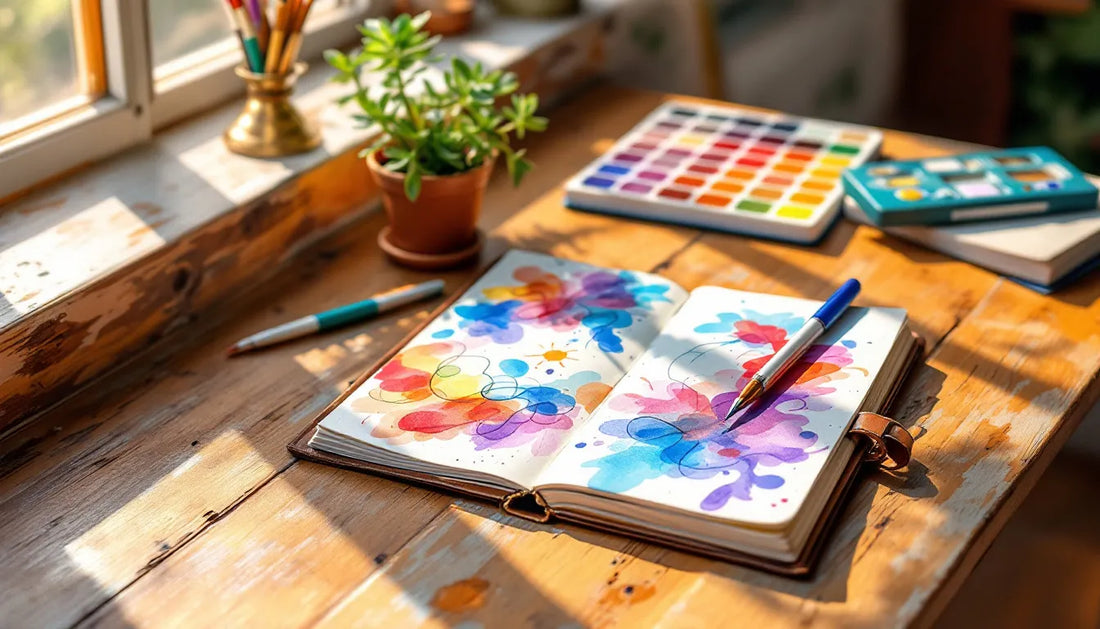
Art Journaling: Boost Self-Reflection in 7 Steps
Share
Art journaling combines creativity and self-reflection to explore your inner world. Here's how to get started:
- Find a quiet spot
- Gather basic art supplies
- Choose a focus topic
- Use a prompt for inspiration
- Let emotions guide your art
- Mix words and images
- Reflect on your creation
Key benefits:
- Emotional outlet
- Stress relief
- Increased self-awareness
- Mindfulness practice
What you need:
- Journal with thick pages
- Pens and paint
- Brushes
- Glue
| Traditional Journaling | Art Journaling |
|---|---|
| Words only | Words and images |
| Can feel like a chore | Often more fun |
| Limited by vocabulary | Expresses the inexpressible |
| Linear thinking | Non-linear, creative thinking |
Remember: It's about the process, not the final product. Start small, be patient with yourself, and let your creativity flow.
Related video from YouTube
Why self-reflection through art matters
Art journaling isn't just about making pretty pictures. It's a powerful tool for self-discovery. Here's why it's so important:
Self-reflection and personal growth
Self-reflection is like a mental workout. It helps you:
- Understand your thoughts and feelings
- Spot behavior patterns
- Identify areas for improvement
Regular reflection leads to positive life changes. But here's the thing: traditional methods don't work for everyone.
That's where art comes in.
Art's impact on self-reflection
Art adds a new dimension to self-reflection:
1. Taps into your subconscious
Creating art often reveals hidden thoughts, leading to surprising self-insights.
2. Safe space for emotions
Some feelings are hard to verbalize. Art lets you express and process these emotions without words.
3. New perspective
Viewing your finished artwork can offer a fresh look at your thoughts and feelings, sparking "aha" moments.
4. Mindfulness practice
Art creation keeps you present, reducing stress and anxiety. This calm state is perfect for self-reflection.
"Art enables us to find ourselves and lose ourselves at the same time." - Thomas Merton
This quote captures why art is so powerful for self-reflection. When creating, you explore your inner world while letting go of everyday worries.
Here's how art journaling compares to traditional journaling:
| Traditional Journaling | Art Journaling |
|---|---|
| Words only | Words and images |
| Can feel like a chore | Often more fun |
| Limited by vocabulary | Expresses the inexpressible |
| Linear thinking | Non-linear, creative thinking |
What you need for art journaling
Want to start art journaling? You don't need much. Here's what you should grab:
Must-have supplies
- Journal: Thick pages that can take paint and water. Try the Kraft Square Ledger Journal from Ranger.
- Pens: Waterproof ones like Faber Castell Pitt Pens.
- Paint: Acrylic or watercolor. Golden Fluid Acrylics are great, or a cheap watercolor set works too.
- Brushes: A basic set like the Dylusions Brush Set from Ranger.
- Glue: Quick-drying liquid glue for sticking stuff in.
Extra supplies to try
Once you're rolling, you might want to add:
| Supply | Use | Try This |
|---|---|---|
| Gesso | Primes pages, covers oops | Any brand |
| Stencils | Patterns and textures | Book Stencil from Stamperia |
| Washi tape | Decorates and layers | Vintage Artistry Countryside Washi Tape |
| Stamps | Backgrounds and focal points | Elements Stamp from Stamperia |
| Texture paste | Adds dimension | Ranger texture paste set |
Don't feel like you need it all NOW. Start small and add as you go.
"I encourage you to grab a journal without lines or grid (blank white pages only), grab your favorite art supplies, and get started." - Torrie, Artist and Blogger
Torrie's got it right. Keep it simple. Grab a journal, some supplies, and dive in. Your art journaling adventure starts here.
7 steps to art journaling for self-reflection
Art journaling can help you dig deep into your thoughts and feelings. Here's how to get started:
1. Find a quiet spot
Pick a comfy place where you can focus. It could be your bedroom, a cozy corner, or even outside. Just make sure it's somewhere you can relax and think.
2. Grab your art tools
You don't need fancy stuff. A simple journal, some paint, a pen, and a pencil will do. As you get into it, you can always add more tools later.
3. Choose your focus
What do you want to explore? Maybe it's a feeling, a recent event, or a problem you're dealing with. Having a focus helps guide your creativity.
4. Use a prompt
Stuck? Try these ideas:
| Prompt | What to do |
|---|---|
| Feelings | Draw your mood |
| Dreams | Show your goals |
| Memories | Sketch a key moment |
| Gratitude | Paint what you're thankful for |
5. Let your emotions guide you
Don't worry about making it perfect. Just express yourself. Use colors and shapes that match how you feel.
6. Mix it up
Add some words to your art. Write down thoughts, quotes, or labels. Combining visuals and writing can lead to new insights.
7. Reflect on your work
When you're done, take a good look at what you've created. What does it tell you about yourself? This step is key for personal growth.
"Art journaling is an incredible way to express yourself and reflect on your life." - Heidi Cogdill, Author
sbb-itb-d0aa3ba
Dealing with common art journaling problems
Art journaling can be tricky. Here's how to tackle some common issues:
Perfectionism paralysis
Worried your art won't be "good enough"? Remember: it's about the process, not the result.
Try this:
- Make a "bad" page on purpose. Go wild!
- Set a 5-minute timer. Create without stopping.
- Cover "mistakes" with paint or collage. No errors, just opportunities.
Lack of ideas
Stuck? Use these prompts:
| Prompt | Action |
|---|---|
| Emotions | Use a color matching your mood |
| Gratitude | List and draw 3 things you're thankful for |
| Dreams | Sketch a symbol for a goal |
| Fears | Write a fear, cover it with empowering images |
Time constraints
Busy? Here's how to fit it in:
- Start small: Even 5 minutes counts.
- Keep supplies handy: Have a small kit ready.
- Make it a habit: Set a specific time for journaling.
Self-doubt and negative self-talk
Criticizing your work? Try:
- Writing negative thoughts, then covering them up.
- Creating an "affirmation page" with positive statements.
- Focusing on how journaling makes you feel, not how it looks.
"Better to do something imperfectly than to do nothing flawlessly." - Robert Schuller
Comparison trap
Feeling "not good enough" because of social media?
- Your journal is for YOU, not for likes.
- Unfollow accounts that make you feel bad.
- Focus on YOUR progress.
Overwhelm from blank pages
Intimidated by empty space? Try:
- Starting with a background color.
- Using washi tape to create sections.
- Beginning with a quote or word in the center.
Making art journaling part of your day
Want to make art journaling a daily habit? Here's how:
Start small and build up
Set a timer for 5-10 minutes. Create without judgment. As you get comfortable, add more time.
Create a portable art kit
Pack a small notebook, pens, and colored pencils. Now you can journal anywhere - during lunch, while waiting, or on your commute.
Use prompts for quick inspiration
Short on time or ideas? Try these prompts:
| Prompt | Action |
|---|---|
| Current mood | Use colors or shapes |
| Gratitude | List or draw 3 things |
| Daily highlight | Sketch a symbol |
| Future self | Write a message |
Integrate with existing routines
Pair journaling with daily activities:
- Morning coffee time
- Lunch break
- Before bed
Embrace imperfection
Don't let perfectionism stop you. Focus on the process, not the result.
"Journaling has been such a powerful tool in my life. It has also helped me with my mental health and finding ways to express myself in a private manner." - Amanda Rach Lee, artist and educator
Speed up the process
Make it time-efficient:
- Use a heat gun to dry pages
- Choose fast-drying materials
- Prepare backgrounds in bulk
Make it a family activity
Journal with family members. It's fun and keeps you accountable.
Conclusion
Art journaling is a powerful self-reflection tool for everyone, no matter your artistic skills. Here's a quick recap of the 7 steps:
- Find a quiet spot
- Pick your art tools
- Decide what to focus on
- Use a starting idea
- Follow your feelings
- Mix words and pictures
- Think about what you made
Remember: It's about the process, not the result. As Tammy Garcia says:
"Art journaling is about the creative process of pulling together color, words, and images as you wish, on a page. Unlike many other forms of art, it is not about the outcome."
Don't stress about making a masterpiece. Just express yourself freely. This practice can:
- Cut stress and anxiety
- Boost self-awareness
- Track emotional growth
- Spark creativity
To make the most of it:
- Set regular time for it
- Try different materials
- Be patient with yourself
Art journaling can change your life. Artist Marie Aguiar Kosik shares:
"The process of art journaling has helped me heal a little easier during more times than I can count. It lets me express my emotions in a healthier way and keeps my mind from dwelling on the sadder aspects of life."
Ready to start? Grab your journal and dive in. Your self-reflection journey through art starts now.
FAQs
Why is art journaling important?
Art journaling isn't just a fun hobby. It's a powerful tool for personal growth and emotional health. Here's why it matters:
It's like a mirror for your inner world. You explore your thoughts and feelings visually. This self-discovery can be eye-opening.
Feeling stressed? Art journaling can help. It's a great way to let go of anxiety by putting your emotions on paper.
Stuck on a problem? The creative process might help you see it differently. New angles can lead to fresh solutions.
Over time, art journaling can boost your emotional resilience. You'll understand and manage your feelings better.
Plus, it's a no-pressure zone. Try new ideas and techniques without worrying about judgment. Your creativity will thank you.
One art journaler put it this way:
"Art journaling has allowed me to deeply touch places in my soul that I never had access to."
It's not just about making pretty pictures. It's about connecting with yourself in a whole new way.
